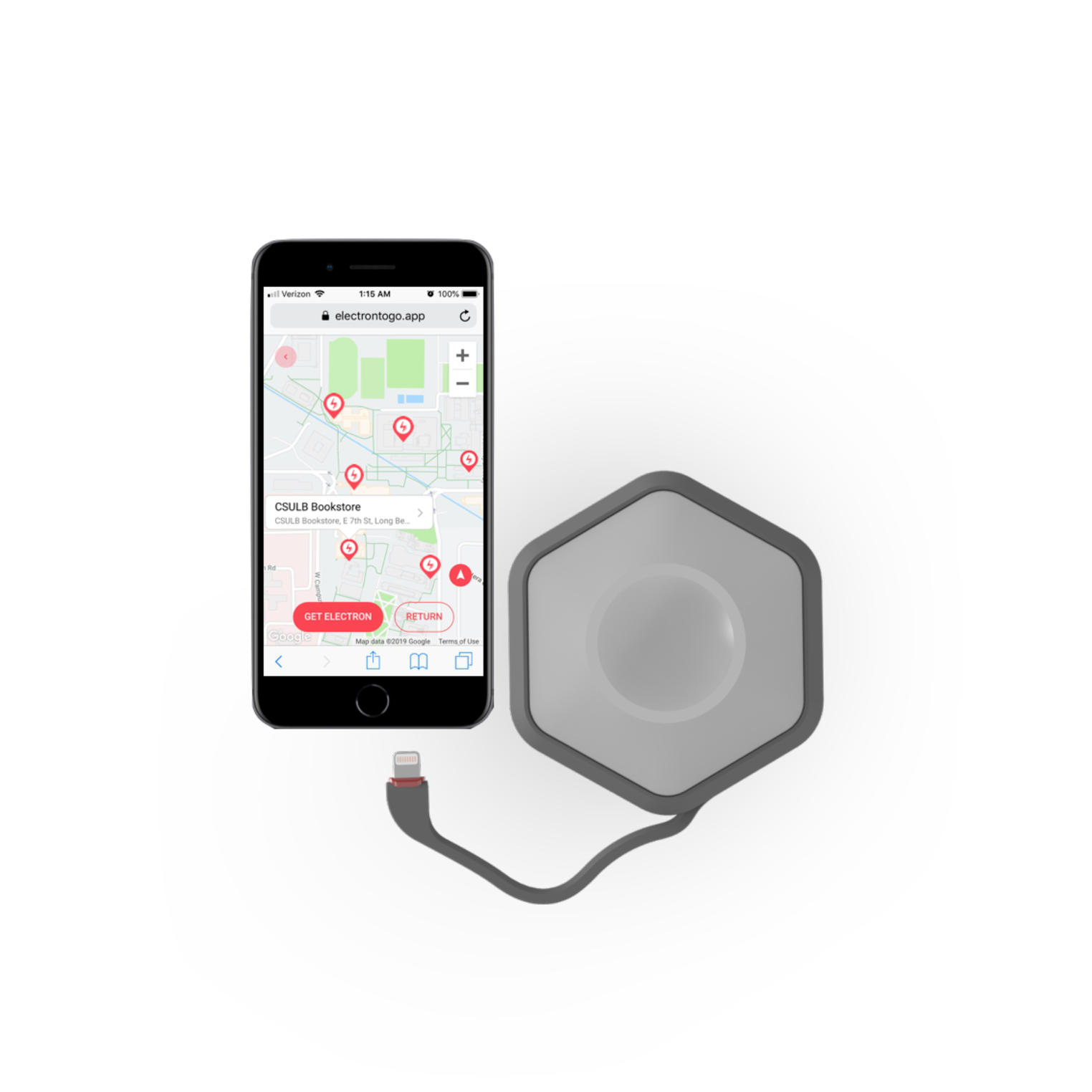Electron-to-Go
Re-imagining portable power
The Opportunity
Sustainable charging with optimal utility
In embracing remote work, the American workforce has made a virtue of necessity, with productivity rising by as much as 47%. That’s thanks in no small part to portable devices like smartphones, tablets, and wireless headsets, which help keep us productive and connected wherever we go. And even when we’re off the clock, those devices play a larger role than ever in keeping us entertained, informed, and connected. But as we rely on devices more heavily and our screen time continues to rise, keeping those devices charged and ready has become a more urgent challenge.
Most smartphone and tablet batteries can power about 5-8 hours of moderate use. Given the more intensive demands of connected work, play, travel, and even family life, those batteries are often at risk of running low when we need then most.
Enter Electron-to-Go, a company looking to reshape public charging solutions with a new generation of sustainable grab-and-go charging units as fully-connected and carefully-designed as the handheld devices they power. The Electron® mobile charger is simple to use, offers support for most mobile device ports, and delivers enough power to fully charge the average smartphone. Deployed in sleek clusters dubbed “Supernovas,” Electrons are reusable, efficient and offer easy connectivity via web app.
“We were looking to remove all the friction points,” says Nasim Muabbat, CEO and founder at Electron-to-Go. “You just register your phone number and receive an SMS code to start using the charging stations.”
These groundbreaking charging devices have already made an impact everywhere from coworking spaces and major university campuses to large company offices and outdoor event and festival spaces.

CEO and Founder, Electron-to-Go“With Soracom, everything was much more efficient. From the pricing to the connectivity… Soracom is our most reliable supplier.”
The Solution
Portable power with minimal waste
Like any great product, the Electron has quietly gone through a number of iterations on its way to market. Based on the material waste he observed in previous roles within the mobile accessories industry, Muabbat set out to create a solution that supports the modern mobile-first lifestyle while keeping a firm focus on sustainability.
“I started with a pretty typical wireless charger,” Nasim recalls. “Based on early prototyping it became clear that the standard design was slow, inefficient, and bad for the environment.”
Surprised by the inefficiencies in the most prominent charging technologies, Muabbat and his team set out to create a solution that eschewed the throwaway design we’ve come to expect from portable chargers, with a functional lifespan extending well beyond the typical battery’s 500-charge cycle.
“It was extremely important to me that the Electrons be easy to repair, easy to replace and easy to recycle,” He added. “When an Electron’s life cycle is complete, we don’t throw it away. We can replace just the battery cell and return the unit to normal service.”
A survey of Electron usage statistics shows that “normal service” can cover a wide range of use cases. Universities and commercial spaces attract a broad but predictably transient user base. Coworking locations tend to yield frequent repeat usage, with individuals returning to the space day after day and becoming habitual customers. It also turned out that coworking users need to charge more than just phones and tablets. Audio headsets typically used for web conferencing are also commonly charged via Electron. When asked their reason for using the service, most Electron users mention not having to bring cables from home.
“It seems insignificant on the surface, but that convenience matters,” said Muabbat.
WHY SORACOM
Pricing, efficiency, and commitment
One of the most important features of the product is that each Electron is autonomous, requiring no external maintenance and no wall outlets to charge your mobile device. The lifecycle and viability of each Electron in the Supernova is monitored and controlled from a central server, meaning connectivity is essential to Electron-to-Go’s operations. As such, it probably comes as no surprise that the company tried out a few connectivity options before partnering with Soracom.
Muabbat initially attempted to launch the Supernovas on a Wi-Fi build, but found challenges obtaining consistent connections – particularly in universities where IT departments tend to keep security tight.
“We quickly realized if we want to be in public places, we need to move to cellular connectivity,” said Muabbat. “Cellular is scalable.”
The team tested out a number of providers, but found that their pricing, security features and customer service were not “startup friendly,” often feeling that interactions with these companies were “too salesy.”
“With Soracom, everything was much more efficient,” said Muabbat. “Everything from the pricing to the connectivity – Soracom never failed us.”
From Soracom’s fully integrated platform, users can monitor the usage and performance of each individual SIM in their deployment and can even adjust their speed class as a cost control measure if needed. Couple this with robust connectivity options that span multiple carriers and connectivity protocols, and it’s easy to see how these solutions would be a natural fit for a product like Electron-To-Go.
“Soracom works flawlessly for us in our U.S. and international markets,” said Muabbat. “Soracom is our most reliable supplier.”

The Outcome
A resilient product with a strong value proposition
Currently, Electron-to-Go has more than 200 Supernovas up and running across the United States, Australia, the United Kingdom, and Japan. Though adoption has slowed in the wake of the pandemic, the company continues to receive inquiries from around the globe.
“In Japan we launched 25 stations across 13 locations as a pilot, and once we have found a distribution partner we hope to increase our presence in the coming years,” said Muabbat.
The applications for the Electrons also keep growing, as Supernovas can be found in everything from schools, coworking spaces, and public transit stations to malls, stadiums, and shipping facilities. One customer has not only installed Supernovas in their home office and training facilities, but actually brings them to trade shows as a means of connecting with prospective customers.
“We know phone usage is going up year after year, but batteries aren’t getting better. So we know our solution is needed,” said Muabbat.
